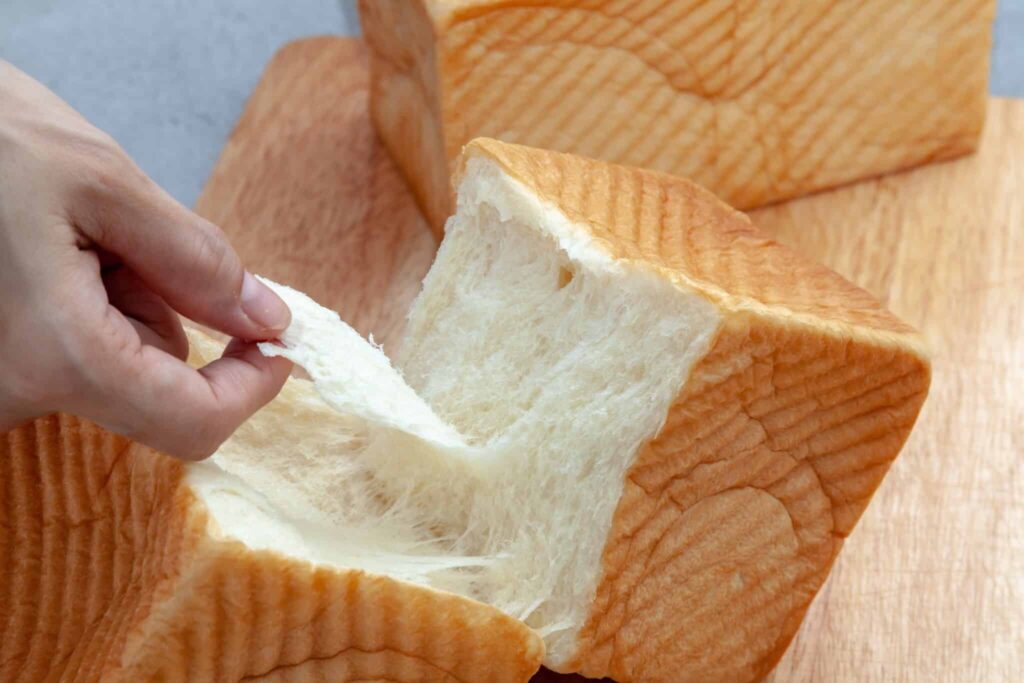[ad_1]
Food fads come and food fads go. A lot of them have gone in the past several years as businesses struggled with lockdowns and greatly reduced demand. Now, another fad – high-end shokupan bread “specialty” shops – looks to be crashing shortly after takeoff.
What is Shokupan Bread?
“Shokupan” is literally just “white bread”. However, while Japanese shokupan is modeled after white bread from Britain, it’s different in form, texture, and taste. Loafs are generally cooked in a large square shape. A combinaton of milk, margarine or butter, and shortening make it significantly sweeter than what many in the West expect “white bread” to taste like. The bread also takes on a fluffy, almost airy texture.
As an American, I love shokupan bread. But I also love disgustingly sweet things. (The Japanese habit of adding sugar even to savory dishes is a technique I fully endorse.) But this opinion isn’t universally shared. While some foreigners rave about shokupan bread, others shun it as “too sweet”.
As if it wasn’t controversial enough, there’s a new kid on the block: so-called “high-end” (高級; koukyuu) shokupan bread. As the name suggests, the difference is in the ingredients. While normal shokupan might use milk and margarine, high-end shokupan will use butter, cream, and other ingredients like honey and a high-grade flour[2].
To make matters even more complicated, you may hear people speak of 生食パン (nama shokupan), where nama means “plain” or “natural/unrefined”. Depending on who you talk to, this refers to high-end shokupan that can be eaten unadorned without being toasted, or to the quality of melting in your mouth like chocolate or caramel[3].
The Appearance – and Disappearance – of “High-End” Shokupan Bread Stores

But what’s a good idea if no one’s making money off of it, right? In 2018, chains such as Sakimoto and Nogami popularized the high-end shokupan bread specialty shop (高級食パン専門店; koukyou shokupan senmonten). The concept took off and stores appeared throughout Japan.
However, as ITMedia Business explains, the new shops weren’t without their detractors. Many users on social media complained that there was nothing “high-end” about the bread (“they’re just adding sugar to it”) and it was just a cash grab. Famous TV personalities Matsuko Deluxe and Ariyoshi Hiroyuki tried some out on their show Matsuko to Ariyoshi Karisome Tengoku and made waves for complaining it was “overly sweet” and “too buttery”[5].
Some experts compared the shops to previous booms, such as the tapioca craze. They predicted that, eventually, the craze would cool.
And cool it has. It can be hard to gather statistics on exactly how many high-end shokupan bread specialty shops have closed. Openings and closures of these stores are typically lumped in with other bakeries. But there are signs that the trend has bottomed out.
One Twitter user visualized this well in a recent tweet that went viral. “I get it, but this is hell,” user @DON12345 griped, and posted a picture of a number of high-end shokupan bread store listings from around the country. All of them were listed as “closed”[6].

Recent headlines seem to bear this out. The site Reiwa Jpn, which tracks store closings, has an exhaustive list of all of the Nogami stores that have closed in the past year alone[6].
High-end shokupan bread: an outdated business model?
So why was there such a run-up if the business model was so bad? Writing for ITMedia Business, Kubota Masaki lays part of the blame on Kishimoto Takuya, the head of Japan Bakery Marketing. The company “produces” some 350 retail bakery outlets in Asia. It’s also known for marketing stores with gimmicky names, like Tokyo Metro’s 考えた人すごい (kangaeta hito sugoi, “Whoever thought of this is awesome”).
The upside of this, says Kubota, is that it stands out and draws attention. But that’s also the downside. When one or more of the stores fail, it draws an equal but opposite – i.e., negative – amount of fanfare.
But Kubota says he also thinks the stores violate another “unspoken rule” of Japanese food: “Meals should be provided to ordinary people at a fair price.” Bread may once have been regarded as more of a luxury food in Japan. But as Japan eats less and less rice and more bread, that equation is quickly changing. Bread is becoming something closer to a staple[5].
Kubota further points out that rice manufacturers attempted to play the same trick with rice. “High-end” rice variations like Koshihikari have dropped dramatically in wholesale price since the 1990s. Kubota links this with the country’s flat wages.
So if you like high-end shokupan bread, enjoy it while it lasts. And wait for the next food fad that grabs the Japanese public’s attention. Don’t worry – I’m sure it’ll be along shortly.
What to Read Next
References
[1] 日本の食パンに海外の反応は?!日本の食パンと海外の食パンの違いをご紹介します!Shokupan Tadami
[2] 高級食パンと普通の食パンの違いを比較!Shokupan Tadami
[3] 乃が美の「生食パン」の「生」の意味知ってた?最高に美味しく食べるコツも伝授.
[4] ちょっと前までブームだったのに、なぜ「高級食パン」への風当たりは強いのか. ITMedia Business
[5] 「分かっちゃいたけど地獄だな」高級食パン専門店が次々と閉店していて諸行無常を感じる「こういうビジネスは次から次へと」. Togetter
[6] 乃が美(のがみ)の閉店店舗一覧リスト(2022年). ReiwaJpn
[ad_2]
Source link



